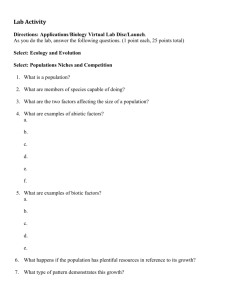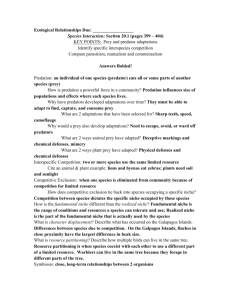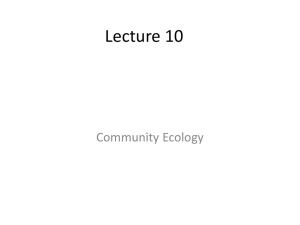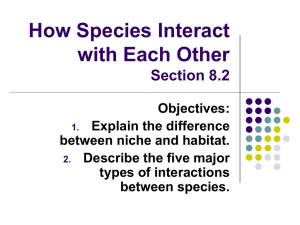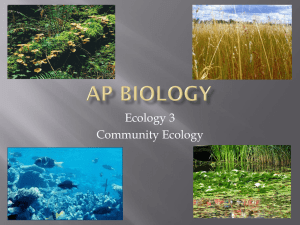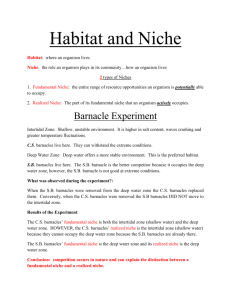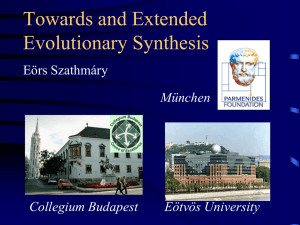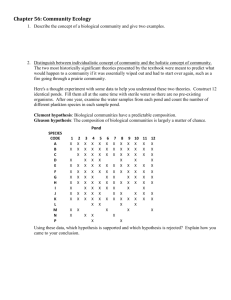BIO102-Ecology Part 2
advertisement
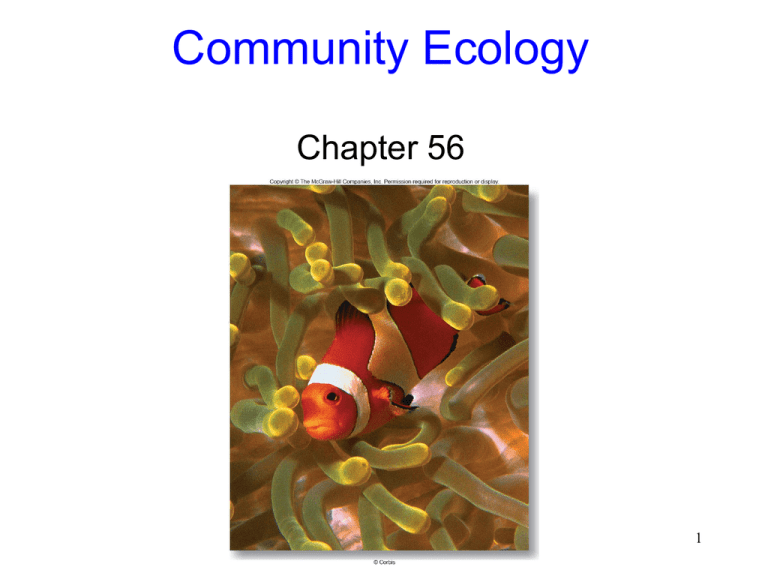
Community Ecology Chapter 56 1 Biological Communities • Community: all the organisms that live together in a specific place – Evolve together – Forage together – Compete – Cooperate 2 Biological Communities • Individualistic concept: a community is a group of species that happen to occur together at one place – species respond independently to changing environmental conditions – The composition of a Community can change 3 Ecological Niche • Niche: An Organism’s way of life – Habitat – Food – Temp. range – Reproduction 4 Ecological Niche • Fundamental niche: the entire niche that a species is capable of using. • Realized niche: actual niche in which the species can establish a stable population 5 Ecological Niche study of barnacles 6 Ecological Niche • causes of niche restriction – Competition – Predators – Absence of pollinators – Presence of herbivores Billock Billock 7 Ecological Niche Principle of competitive exclusion: no two species can occupy the same niche when resources are limited •Species may divide up the resources, (resource partitioning) •natural selection can then lead to adaptive radiation 8 Resource partitioning among sympatric lizard species 9 Ecological Niche Character displacement in Darwin’s finches 10 Predator-Prey • Predation and coevolution 1. Predation provides strong selective pressure on the prey population 2. Features that decrease the probability of capture are strongly favored 3. Predator populations counteradapt to continue eating the prey Coevolution race 11 Examples of prey adaptations: •Chemical defenses •Camouflage •Warning coloration •mimicry 12 Species Interactions • Symbiosis: two or more kinds of organisms interact in more-or-less permanent relationships • All symbiotic relationships carry the potential for coevolution • Three major types of symbiosis – Commensalism – Mutualism – Parasitism 13 Species Interactions • Commensalism benefits one species and is neutral to the other – Spanish moss: an epiphyte hangs from trees 14 Shark and Pilot Fish Barnacles and Whales Species Interactions • Mutualism benefits both species • Coevolution: flowering plants and insects Ants and acacias – Acacias provide hollow thorns and food – Ants provide protection from herbivores 17 Human Intestine and E.Coli Zebra and Oxpecker Bird Species Interactions • Parasitism benefits one species at the expense of another • Can be external or internal parasites 20 Species Interactions External parasite: the yellow vines are the flowering plant dodder, it is a parasite that obtains its food from the host plant it grows on 21 Heartworm and Dogs Mistletoe and Mesquite Tree Species Interactions • Ecological processes can interact – Predation reduces competition • Superior competitors become more numerous and attract predators • This allows other species to survive when they could have been out competed 24 Species Interactions Starfish eat barnacles, allowing other species to thrive instead of being crowded out by the explosive population of barnacles 25 Species Interactions • Keystone species: species whose effects are greater than expected • Examples: – Sea star predation on barnacles – Beaver ponds – Top predators 26 Species Interactions Beavers construct dams and transform flowing streams into ponds, creating new habitats for many plants and animals 27

